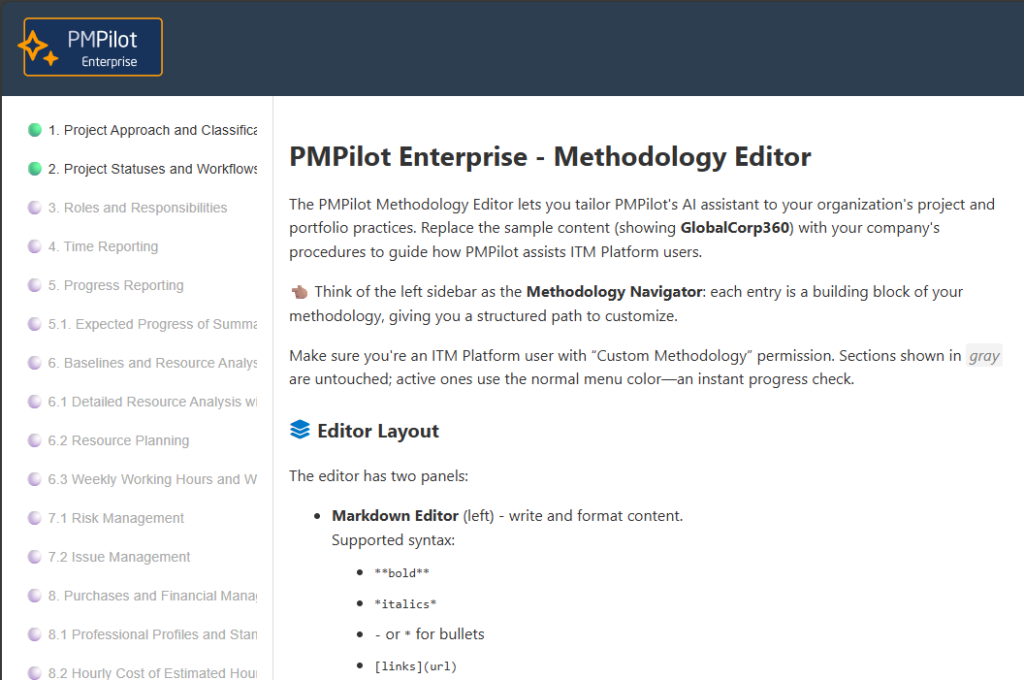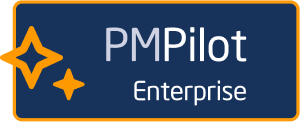How AI and PMPilot Enterprise bridge the gap between static rules and real-world decisions

1 | Methodology 101 — more than a process map
A project-management methodology is the sum of the rules, roles, and checkpoints that steer every project in an organization. At minimum, it answers five questions:
| Question | Typical content |
| How do we classify work? | Waterfall vs. Agile guidelines, standard phases, sprint cadence. |
| What are the official statuses? | Proposed → Planning → In Progress → … — plus who can move a project between them. |
| Who does what? | Project Manager, Task Manager, Team Member, approvers. |
| How do we measure? | Baselines, expected vs. actual progress, resource thresholds. |
| How do we handle uncertainty? | Risk definitions, probability × impact scales, escalation paths. |
When these elements are explicit—and easy to find—teams make faster decisions and data stays comparable across the project portfolio.
2 | Why most methodologies fail in real life
- Static PDFs languish in shared drives.
- One-size-fits-all templates ignore local quirks.
- Tacit know-how lives with a handful of veterans, so new hires keep asking “what’s the real process?”
- Creating a project management methodology seems like an insurmountable task, so the methodology is never clearly articulated.
The result: status names drift, risk logs are incomplete, and financial data become apples and oranges.
3 | An anatomy you can trust
A usable methodology has three layers:
| Layer | What to document | Practical example |
| Foundation | Classification, lifecycle, roles. | When to choose Waterfall: well-defined scope, sequential phases; Agile: evolving scope, short feedback loops. |
| Governance | Status workflows, approval rules, thresholds. | Moving from Proposed to Planning requires PMO sign-off; purchases > $5,000 need CFO approval. |
| Control & Learning | Baselines, resource analysis, risk & issue management. | Weekly progress vs. baseline; risks logged if probability × impact ≥ 10; resource overload flagged at 120 %. |
Documenting is only half the battle—the real challenge is helping people use the rules without stopping their work.
4 | Where AI makes the difference
Modern language models can:
- Parse a natural-language question (“Who approves equipment over €10 000?”)
- Locate the specific clause in your methodology
- Reply inside the tool where the user is already working
No more scrolling through wikis or pinging the PMO channel. Answers stay consistent, version-controlled, and traceable to the original policy.
5 | Enter PMPilot Enterprise inside ITM Platform
PMPilot began as a help-center bot. The Enterprise extension lets you train it with your own methodology so every response reflects your governance.
5.1 Guided template → first draft in hours
Open the Methodology Editor and a left-hand navigator walks you through sections such as Approach & Classification, Statuses & Workflows, Risk Management, and Resource Planning. Each block includes theory plus editable examples—ideal if you’re formalising a methodology for the first time.

5.2 Instant distribution
Hit Save and PMPilot retrains in the background. From that moment any ITM Platform user can:
- Chat with PMPilot in plain English
- Click context links on project or purchase screens to view the relevant rule
- See updates whenever the PMO edits a section
5.3 Living governance
Because the knowledge base and the operational data sit side-by-side, feedback loops are short:
| Trigger | What changes | How long it takes |
| KPI shows risk logs only 50 % complete | PMO adds a one-liner clarifying risk thresholds | < 10 min |
| New regulation on data residency | Add a Compliance section, retrain | < 30 min |
| Team spots conflicting advice | Editor flags duplicate entries for review | Continuous |
6 | Deep-dive examples your teams will recognize
- Status workflow in action — A developer tries to mark a project Completed. PMPilot reminds them that financial reconciliation must finish first and points to the “Closed” criteria.
- Waterfall vs. Agile debate solved — A PM asks whether a data-migration should run Agile. PMPilot returns your decision tree: fixed-scope migrations stay Waterfall; prototypes go Agile.
- Risk escalation — A tester logs a threat with score = 22. PMPilot explains it’s “High”, shows the mitigation template, and tags the PMO for approval.
7 | Adoption roadmap (4 weeks, part-time)

| Week | Milestone | Activities |
| 1 — Inventory | Collect SOPs, slides, wiki pages | Decide what stays, what needs rewriting |
| 2 — Template pass | Populate Editor with current practices | Replace placeholders, keep gaps visible |
| 3 — Review & pilot | Train PMPilot; test in a sandbox | Gather user feedback, adjust wording |
| 4 — Go live | Switch to production | Announce, run mini-clinics, set review cadence |
Not ready for production? Flip the Demo switch and experiment with the sample “GlobalCorp360” methodology risk-free.
8 | Key takeaways
- A clear methodology turns individual projects into a coherent portfolio.
- AI converts that methodology from a static document into real-time guidance.
- PMPilot Enterprise embeds the guidance where people already work—inside ITM Platform—so adoption feels natural, not forced.
Spend an afternoon with the Editor, ask PMPilot a few tough questions, and see how quickly “the way we’ve always done it” becomes the way everyone actually does it—consistently, confidently, and with much less friction.
Sign up for a 14-day ITM Platform (with PMPilot) free trial
